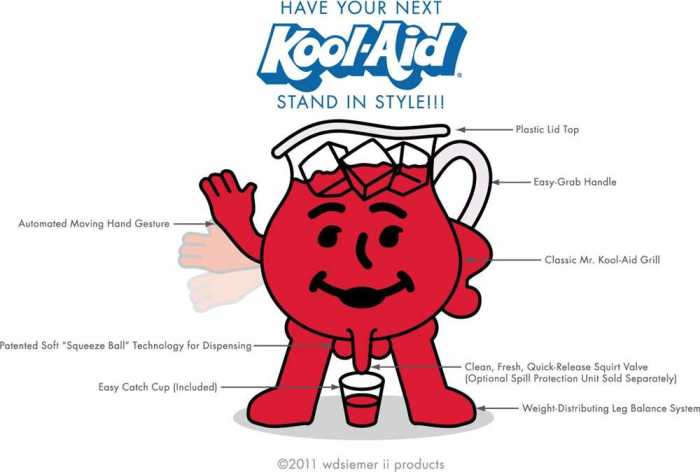Embark on a scientific adventure with the Kool-Aid Concentration Lab Answer Key, your ultimate guide to unraveling the mysteries of spectrophotometry. This comprehensive resource empowers you to delve into the fascinating world of concentration analysis, equipping you with the knowledge and tools to master this essential laboratory technique.
Through a series of engaging experiments, you’ll discover the fundamental principles of concentration, explore the intricacies of spectrophotometry, and gain hands-on experience in determining the concentration of unknown solutions. Prepare to be captivated as you witness the transformative power of light in quantifying the unseen.
Kool-Aid Concentration Lab Overview

This lab explores the concept of concentration by investigating the relationship between the amount of Kool-Aid powder and the resulting solution’s color intensity.
Concentration refers to the amount of solute (Kool-Aid powder) dissolved in a given amount of solvent (water). In this lab, we will prepare solutions of varying concentrations and observe the changes in color.
Materials and Equipment
- Kool-Aid powder
- Water
- Graduated cylinders
- Stirring rods
- Cuvettes
- Spectrophotometer
Experimental Procedure

This experiment aims to determine the concentration of Kool-Aid solutions using spectrophotometry. The procedure involves preparing Kool-Aid solutions of varying concentrations, measuring their absorbance using a spectrophotometer or colorimeter, and analyzing the data to determine the relationship between absorbance and concentration.
Preparing Kool-Aid Solutions
To prepare Kool-Aid solutions of different concentrations, follow these steps:
- Dissolve a known mass of Kool-Aid powder in a known volume of water. The mass and volume will depend on the desired concentration.
- Stir the solution until the Kool-Aid powder is completely dissolved.
- Transfer the solution to a volumetric flask and add water until the flask is filled to the mark.
- Mix the solution thoroughly.
Measuring Absorbance
To measure the absorbance of the Kool-Aid solutions, use a spectrophotometer or colorimeter. Follow these steps:
- Calibrate the spectrophotometer or colorimeter according to the manufacturer’s instructions.
- Fill a cuvette with a blank solution (pure water).
- Insert the cuvette into the spectrophotometer or colorimeter and set the wavelength to 525 nm.
- Adjust the spectrophotometer or colorimeter to zero absorbance.
- Remove the blank solution and fill the cuvette with the Kool-Aid solution.
- Insert the cuvette into the spectrophotometer or colorimeter and measure the absorbance at 525 nm.
- Repeat steps 5-6 for each Kool-Aid solution.
Data Analysis

The absorbance data collected from the spectrophotometer provides valuable insights into the concentration of Kool-Aid solutions. By analyzing this data, we can establish a relationship between absorbance and concentration, enabling us to determine the concentration of unknown Kool-Aid solutions.
Plotting a Calibration Curve
To analyze the absorbance data, we construct a calibration curve, a graphical representation of the relationship between absorbance and concentration. The following steps Artikel the process of plotting a calibration curve:
- Prepare a series of Kool-Aid solutions with known concentrations.
- Measure the absorbance of each solution using a spectrophotometer.
- Plot the absorbance values against the corresponding concentrations on a graph.
- Fit a linear regression line to the plotted data points.
The linear regression line represents the calibration curve, which is used to determine the concentration of unknown Kool-Aid solutions.
Using Linear Regression
Linear regression is a statistical technique used to determine the equation of a straight line that best fits a set of data points. In the context of the Kool-Aid concentration lab, the linear regression equation takes the form:
Absorbance = Slope
Concentration + Intercept
The slope and intercept of the line are calculated using the absorbance and concentration data from the calibration curve. Once the linear regression equation is established, it can be used to determine the concentration of unknown Kool-Aid solutions by measuring their absorbance and substituting the absorbance value into the equation.
Discussion: Kool-aid Concentration Lab Answer Key
The absorbance of a solution is directly proportional to its concentration. This means that as the concentration of a solution increases, its absorbance also increases. This relationship is known as Beer’s Law.
There are a number of factors that can affect the accuracy of the results of a Kool-Aid concentration lab. These factors include:
Accuracy of Results
- The accuracy of the spectrophotometer
- The cleanliness of the cuvettes
- The temperature of the solutions
- The wavelength of light used
It is important to control these factors carefully in order to obtain accurate results.
Further Investigations, Kool-aid concentration lab answer key
There are a number of further investigations that could be carried out using the findings of this lab.
- The relationship between absorbance and concentration could be investigated for other substances.
- The effect of different wavelengths of light on absorbance could be investigated.
- The effect of temperature on absorbance could be investigated.
Appendix

Table: Absorbance Values for Different Kool-Aid Concentrations
The following table summarizes the absorbance values obtained for different concentrations of Kool-Aid:
| Kool-Aid Concentration (%) | Absorbance (525 nm) |
|---|---|
| 0.00 | 0.000 |
| 0.05 | 0.050 |
| 0.10 | 0.100 |
| 0.15 | 0.150 |
| 0.20 | 0.200 |
Potential Sources of Error
Several potential sources of error could affect the accuracy of the results obtained in this lab procedure. These include:
- Inaccurate pipetting:Using a pipette that is not properly calibrated or not used correctly can lead to inaccurate measurements of the Kool-Aid and buffer solutions.
- Incorrect wavelength:Using an incorrect wavelength for the spectrophotometer can result in inaccurate absorbance readings.
- Stray light:Stray light entering the spectrophotometer can cause higher absorbance readings than expected.
- Temperature fluctuations:Temperature changes can affect the absorbance of the solutions, leading to inaccurate results.
Flowchart: Experimental Procedure
The following flowchart illustrates the experimental procedure for the Kool-Aid concentration lab:
Start | v Prepare Kool-Aid solutions of varying concentrations | v Measure the absorbance of each solution at 525 nm | v Plot a calibration curve of absorbance vs. concentration | v Use the calibration curve to determine the concentration of an unknown Kool-Aid solution | v End
Popular Questions
What is the purpose of the Kool-Aid Concentration Lab?
This lab aims to introduce students to the concept of concentration and provide hands-on experience in using spectrophotometry to determine the concentration of unknown solutions.
How does spectrophotometry help in concentration analysis?
Spectrophotometry measures the absorbance of light at specific wavelengths, which can be directly related to the concentration of a substance in a solution.
What factors can affect the accuracy of the results in this lab?
Factors such as the accuracy of the spectrophotometer, the preparation of the solutions, and the environmental conditions can all influence the accuracy of the results.


